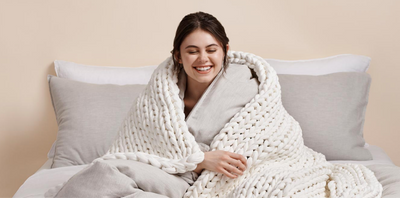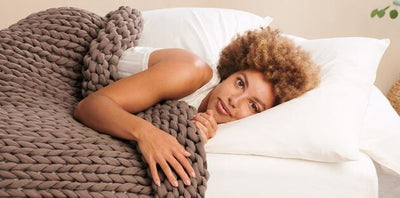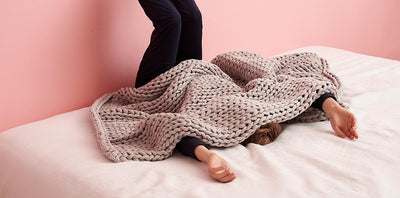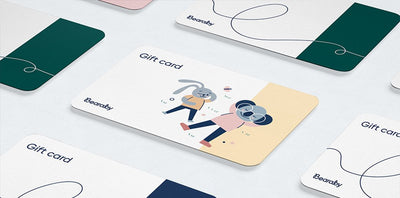8 Different Pillow Filling Types, Their Benefits, and More
There are many pillow filling types, from all-natural products that have been used for centuries like down feathers and buckwheat to modern, processed materials like polyester. Depending on what a pillow is stuffed with, it can be more or less shapeable, expensive, eco-friendly, and hypoallergenic.

Bearassentials
The basic types of pillow filling are foams, bead-types, and fluffy fillings. Choosing the right one depends on your sleeping style and climate needs.
Some of the best natural pillows are made with latex, buckwheat, cotton, and feathers.
Synthetic pillow types include stuffing like polyester, microbeads, and petroleum-based foam.
Did you know?
People are always looking for a better pillow filling and the search is far from over. In recent years bamboo and hemp pillows have grown in popularity along with more synthetic types like gel pillows.
Heading to the great indoors of your nearest shopping mall to pump up your sleeping setup? Trying to get it all done from home and wondering how all of the pillow filling types out there differ?
These days there are more head pillows to choose from than ever before, from all-natural fillers to synthetic products. Each one comes with its advantages and disadvantages.
Highlighting qualities like budget-friendliness, shape, eco-friendliness, and more, this guide will dive into the most popular options on the market.
How to Decide on a Pillow Filling Type
Before getting into the different pillow filling types, consider what you want to prioritize.
Are you looking for a stiff material? A shapeable material? Are you an eco-friendly champion trying to save the environment one pillow at a time? Willing to do that only if it doesn’t hurt your bottom line? Many of these factors can impact the way you sleep at night.
There’s also your preferred sleeping position to consider. For example, side sleepers may be better off sleeping on pillows that are a little thicker while back sleepers often prefer something thinner and more shapeable for the neck’s natural curve.
No matter how you prefer to sleep, there’s a fitting pillow out there for you.

1. Latex
Among the most popular recent developments in pillow technology is latex. When many people think of this material, rubber gloves or super hero suits might come to mind, but it’s a lot more adaptable than that. And in recent years producers have used it to create a foam pillow filling that makes the perfect cushion
There are several ways to produce latex, and in the past companies often relied on petroleum-based ingredients that are terrible for the environment. However, several new products have hit the market that achieve the same or better results while giving the planet some love.
Our pillows at Bearaby are filled with one of those eco-friendly types. It’s called Melofoam and we make it with the sap of eucalyptus trees, processing it into a cushy foam that’s ideal for snuggling.
Melofoam is the backbone of pillows like our Cuddler body pillow, Hugget knot pillow, and Cuddling bolster pillow.
Here are some of the pros of latex pillow filling:
- Cushy material that can be great for back or side sleepers depending on pillow size
- Shredded options are available for a fluffier feel
- Environmentally friendly option
Cons of latex filling
- Some forms of latex are petroleum-based
- May get hot in the summer
- Can be expensive
2. Down Pillow Stuffing
For a more traditional pillow filling, turn to down. It’s been the gold standard stuffing in pillows and sleeping bags for years, partly because it’s soft and cozy, and partly because it’s also great at keeping its user warm.
The material comes from the layer of feathers closest to the skin in birds such as geese and ducks. This under coat is much softer than the upper layer and doesn’t include the stiff quills found elsewhere, making it fluffy and highly shapeable.
Unfortunately getting a hold of these precious feathers can be harmful to the birds, which is why organizations like PETA recommend staying away.
Here are some of the pros of down pillow filling:
- Fluffiness makes it a good option for back sleepers
- Durable and can be refilled
- Can be easily shaped
Cons of down filling:
- Often unethically sourced and harmful to animals
- Absorbs and traps a lot of heat from the body
- Tends to clump up
- Expensive
3. Feather Pillow Stuffing
If you like the idea of sleeping on a down pillow but want something that may be less harmful to the birds (and your wallet), consider going the feather route.
As opposed to down filling, ordinary feathers are plucked from the upper layers in the bird’s coat. Typically this means wing or back feathers.
The downside of feather pillow stuffing compared to down is that feathers aren’t quite as fluffy and they also contain quills which can be uncomfortable. However, the quills are usually small and won’t bother you.
Here are some of the pros of feather pillow filling:
- Cheaper and possibly more ethical than down
- Almost as fluffy and shapeable as down
Cons of feather filling:
- Some feather quills can be uncomfortable
- May need to be re-shaped often
4. Buckwheat Pillow Filling
For another natural option, consider a pillow filled with buckwheat husks. People in Japan have been using them forever and it’s no wonder why. They’re a great use of a food byproduct, are firm while also shapeable, and serve as a cool option during the humid Japanese summers.
Recently these pillows have grown in popularity around the globe for the same reasons and with relatively few drawbacks. The main one is that some people don’t like how stiff they can feel. The other has to do with reports of allergic reactions in some.
Here are some of the pros of buckwheat pillow filling:
- Memory-like properties, but firm
- Good option for staying cool
- Natural option
Cons of buckwheat filling:
- Shuffling sounds can be annoying
- Some have troubles with allergies
- Shapeable, but has limits

5. Memory Foam Pillow Stuffing
Out with the old, in with the new. As the name suggests, memory foam is a material that shapes itself to your form as you lay on it, and when you get off the bed it slowly plumps back up.
This pillow filling type can be a great option for some back sleepers who tend not to move around too much during the night. It molds itself around the curve of your neck and keeps it in place, which is crucial for those dealing with sleep-related stiff necks.
Here are some of the pros of memory foam pillow filling:
- Shapes itself to different body types
- Supports the neck during sleep
Cons of memory foam filling:
- Absorbs body heat and gets very hot
- Not as durable as latex options
- Often petroleum-based
6. Polyester Fiberfill Pillow Stuffing
Another one of modern standards is polyester fiberfill, but that’s slowly changing as people make note of the drawbacks.
As a plastic-based product its production is harmful for the environment. For the same reason, it’s a nightmare from a waste management standpoint. On top of that, there’s evidence to suggest that using this type of pillow stuffing can be harmful for your health and may even be cancer-causing.
If you’re not worried about that, polyester fiberfill pillows are good for other reasons, mainly their cost-effectiveness and ability to shed heat.
Here are some of the pros of polyester fiberfill pillow filling:
- Maintains its shape well while being fluffy
- Can be a cool option for summer
Cons of polyester fiberfill filling:
- Made of toxic materials that may be bad for your health
- Among the worst materials for the environment
- Very difficult to re-shape
7. Cotton
For a nearly identical option to polyester that’s all-natural, turn to cotton. These pillows are cool in the summer, fluffy while still being shapeable, and they’re not much more expensive.
On top of that, you can rest easy knowing that you’re being a little easier on your health and Mother Nature’s
Here are some of the pros of cotton pillow filling:
- Organic and eco-friendly options available
- Relatively cool
- Cheap
Cons of cotton filling:
- Not very long-lasting
- Tough to re-shape
8. Microbead Filling
One of the biggest pillow fads in recent years is microbead filling. Think of something similar to the little white balls that may have spilled out of your favorite bean bag chair when you were a kid. The beads in these pillows are usually much smaller though, so take care!
One of the other characteristics of microbead pillows that defines them is that the casing is usually made with a stretchy material such as lycra or even spandex. This can make these pillows squishier than most.
Here are some of the pros of microbead pillow filling:
- Highly adaptable for different head/neck shapes
- Can be cooling depending on design
Cons of microbead filling:
- Often made with polystyrene, a plastic product
- Some people complain of chemical odors
- Too squishy for some
FAQs
Got more questions about pillow filling types? Here are some of the common ones and their answers.
What is the Best Natural Pillow Filling?
Some of the best natural pillow filling options are naturally-sourced latex, cotton, and buckwheat. They each represent very different options and can all be good fits depending on your needs.
Latex is great for those looking for a durable foam option that forms around your shape. Cotton is a fluffier and cheaper option that’s wonderful for back sleepers trying to stay cool. And Buckwheat is a firm, yet shapeable option perfect for side or back sleepers as it comes in different sizes. Cotton and buckwheat are both great cooling pillow options
What is Best Filling For A Pillow?
The best filling for pillows depends on your budget, climate, and what type of sleeper you are. One of the best all-around pillow filling types is latex because it can be naturally sourced, is durable, supports back and side sleepers well, and has different pricing options.
For a cheaper, fluffier option cotton can be a great choice and many people enjoy the shapeable qualities of feather pillows. Ultimately, there is no ‘best filling for pillows’ because each person has very different tastes.
What is Kapok Pillow Filling?
Kapok pillow filling is a fluffy material very similar to cotton that comes from the kapok tree, common in tropical areas. Manufacturers use kapok in many different products from life preserving jackets to bedding materials like cushions and mattresses.
Kapok pillow filling is moisture-resistant, like cotton, and also dries very quickly. This, combined with its fluffiness makes it a great all-natural choice for pillows, especially if you’re looking for a pillow geared toward summer weather.
Conclusion
There are dozens of pillow filling types out there and people are inventing more all the time. Purchasing synthetic pillows like microbead and polyester fiberfill pillows may be a little easier on your wallet, but they have the opposite impact on the environment and potentially your own health.
For an eco-friendly option consider naturally-sourced latex options like our Melofoam Cuddler, Hugget, and Cuddling options. If foam isn’t your thing there are plenty of other stuffing types like feather, buckwheat and cotton. Match them to your preferred sleeping style and you may soon be drifting off to a peaceful sleep.






